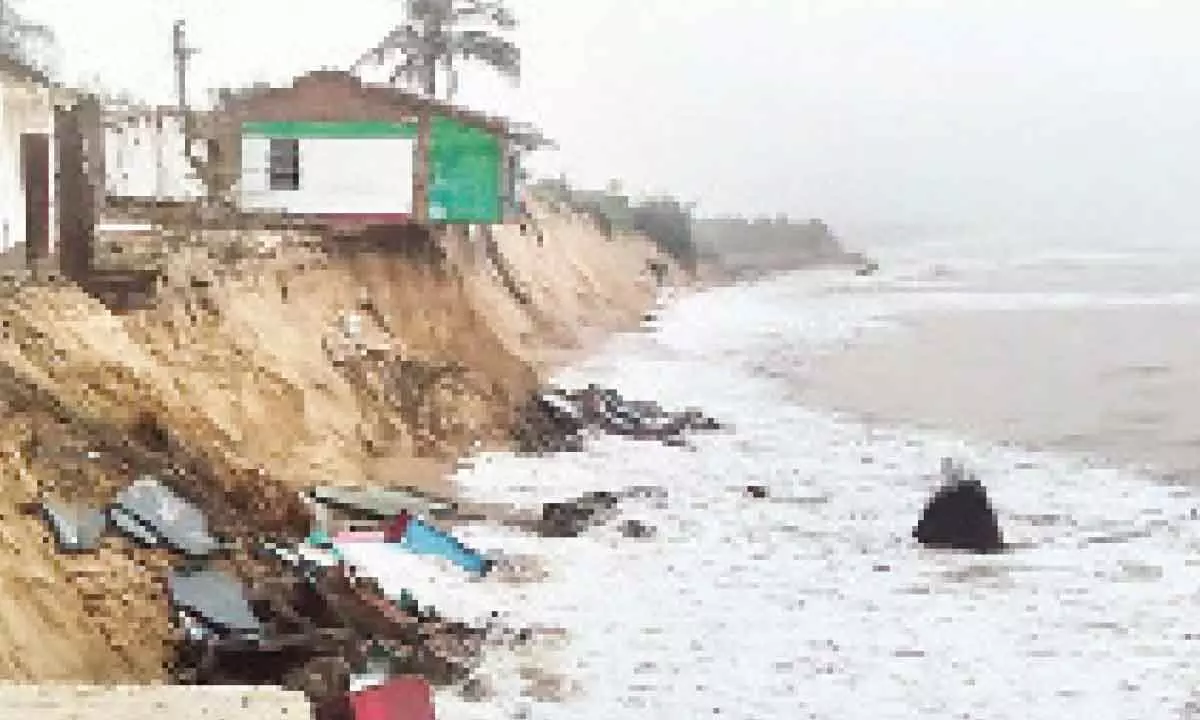Live
- Abhishek Reddy Campaigns for Father's Victory in Udayagiri Constituency"
- MLA Mekapati Vikram Reddy says people eagerly waiting for Jagananna's Manifesto"
- MLA Candidate Satya Kumar Yadav Welcomes 50 Families to BJP, Credits Party for Global Recognition of India"
- NDA Alliance Candidate Badeti Radhakrishnaiah (Chanti) Campaigns in Eluru Constituency with Bicycle Symbol"
- TDP Is the only party that stands by farmers, says NDA alliance candidate Julakanti
- "Mana Kosam Mana Nayakkar Program Organized in Narasapuram Constituency by Janasena, TDP and BJP Parties"
- Keshineni Shivnath Leads Major Additions to TDP as City Celebrities Join in Support
- Srikakulam: TDP dissident leader Venkata Ramana relents
- KTR to hoist party flag on Formation Day today
- KCR, KTR, Harish hit campaign trail
Just In
Odisha’s eroded coastline exposes villages to storm surges


Bhubaneswar: Owing to its proximity to the Bay of Bengal, Odisha has been bearing the brunt of climate change with the regular occurrence of...
Bhubaneswar: Owing to its proximity to the Bay of Bengal, Odisha has been bearing the brunt of climate change with the regular occurrence of devastating tropical cyclones, increasing volume of lightning, irregular rainfall and coastal erosion. “With over 480 km of coastline, Odisha is in a precarious position when it comes to the impact of climate change,” says Odisha State Action Plan on Climate Change (Phase-II). The document also mentions that Odisha’s coast is vulnerable to cyclones as well as chronic problems associated with shore erosion, coastal flooding, storm surge and inundation. Studies conducted by several other reputed government and non-government organisations have also echoed the same warning that large parts of coastal Odisha under Ganjam, Puri, Jagatsinghpur, Kendrapara, Bhadrak and Balasore districts are at greater risk of deluge and inundation due to erosion of coastal lands.
“Many coastal villages in Kendrapara, Ganjam and Puri districts are experiencing increased levels of inundation and storm flooding, accelerated coastal erosion, seawater intrusion into freshwater, including groundwater and encroachment of tidal waters into river systems. All these lead to multiple displacements and the poor living on the margins of subsistence are forced into greater poverty,” said environmentalist and researcher Ranjan Panda.
Those living in the sea coast have been facing acute shortage of drinking water and loss of their livelihoods as huge patches of arable lands were eaten away by the rising sea waves.
While sharing her ordeal, an elderly, Bengalata Rout, of Tandahar village in Astaranga block of Puri district, said, “In my younger days, the villagers had to cover a long distance to go to the sea for fishing or any other work. But, now the sea has come so close to our village that we are staring at displacement. Around 20 to 30 acres of agricultural land where we used to grow rice and other crops have been submerged in sea during the last couple of years.”
On the other hand, Tandahar village, with a population of around 1,000 persons, has only one handpump for drinking water. The situation is precarious in Udayakani village of the same block as the residents have been buying drinking water from a place around 4 to 5 km away. Piped drinking water supply is a distant dream for the residents of these two villages.
“We are living a miserable life after the destructive super cyclone in 1999. Since then, the sea waves continue to expand inundating our land with every passing year. We have already been displaced twice due to the shore erosion. All our agricultural lands are either submerged or filled with salt water and sand forcing us to work as daily labourers in nearby villages,” said Siba Pradhan of Udayakani.
The Forest department officials have been planting casuarinas and mangroves to create artificial forests at regular intervals but their efforts are not yielding satisfactory results due to the lack of proper care, Pradhan alleged.
The womenfolk of the area and some local activists are taking up the task of creating jungles in the area. The women residents of Tandahar have been planting mangroves and casuarina trees in the area to check erosion.
“Such situations are already forcing many people to migrate. We urgently need rehabilitation policies for supporting these climate migrants and displaced people so that their right to life with dignity is protected,” said Panda.

© 2024 Hyderabad Media House Limited/The Hans India. All rights reserved. Powered by hocalwire.com






